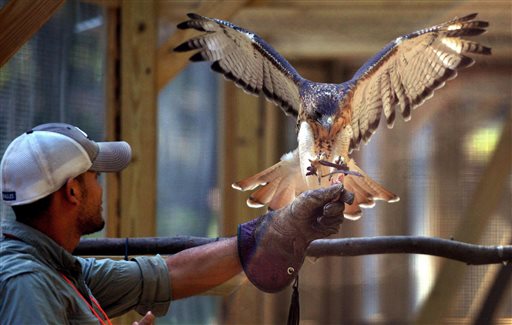Raptors get schooled at Savannah wildlife center
Tuesday, September 2, 2014
SAVANNAH, Ga. - Training a red-tailed hawk to fly on command takes a little bit of quail meat, a few dead rats and a whole lot of patience.
James Fleullan pulled out all three recently at Oatland Island Wildlife Center. Fleullan, soft-spoken 34-year-old volunteer, positioned himself about five feet from the perch of a red-tailed hawk named Hunter. His gauntleted right hand held up a defrosted baby rat. Fleullan blew a whistle and pointed to the rat with his left hand. After a few false starts, Hunter was gulping down his first meal of the day.
It's all about positive reinforcement.
"It's like a dog with a ball or a cat with a laser pointer," Fleullan said. "They really enjoy doing it."
To make sure Hunter is focused on the rats and quail meat that serve as rewards, keepers don't feed him the day prior to a training session. Fleullan keeps careful track of the bird's weight before each training session. On Monday the fasting bird weighed in at a little more than two pounds, a healthy weight for an adult male, the smaller of the sexes in hawks.
In training, Hunter was especially keyed into the quail meat, a new food for the hungry bird.
Much of the time, Hunter sat on his perch making a tiny peep incongruous with his size and majesty. It's a food-begging sound, said Fleullan, an outdoorsy Texan who learned raptor care and training in a work-study position he held at Georgia Southern University's raptor center while earning his marketing degree.
Hunter should have outgrown that peeping behavior by now, Fleullan said, but instead the bird has imprinted on people. He was brought to Oatland in April of last year with a leather anklet around his leg. But no one responded to announcements about a found trained bird, a sign to Fleullan that the original owner may not have had the proper permits to keep a red-tailed hawk.
With Hunter already used to people, it's taken Fleullan only since the beginning of August to get him to begin flying to his gloved hand and back to his perch on command. He expects him to be show-ready by about late October.
Most raptors and especially red-tails can be aggressive, a fact one bird taught Fleullan with a quick rip of her talons that left him with a tear to the bone in his finger. Six stitches, many years and a thin white scar later he shrugs it off, but is careful to slip on his well-worn gauntlet before handling Hunter.
"These talons are razor sharp," he said pointing out the hawk's one backward-facing claw and three forward-facing ones.
Fleullan is hoping to train enough birds to have a program where several birds fly from perch to hand and back again on command.
"If we get more birds like Hunter we could have a flighted program, " said Fleullan, the camping team lead at Bass Pro Shops. "It would be interesting and educational for kids."
Grown-ups, too. As it is, the center is developing two live animal shows, said veterinarian Lesley Mailler. One focuses on the raptors Fleullan is training. The other is reptiles and mammals.
Raptors, with their combination of grace and power, are always a draw, Mailler said.
"They're so diverse with their adaptations for hunting," she said. "Plus, everybody wants to be able to fly."
For now, Fleullan plans to train three other birds along with Hunter: a bald eagle named Wassaw, a peregrine falcon named Womack and an unnamed barred owl. They'll most likely learn to sit on a gloved hand rather than fly on command. Another barred owl, Wahoohoo, is something of an elder statesman at the center and won't be asked to learn any tricks from a new trainer, Fleullan said.
"It's one bird at a time," he said.

